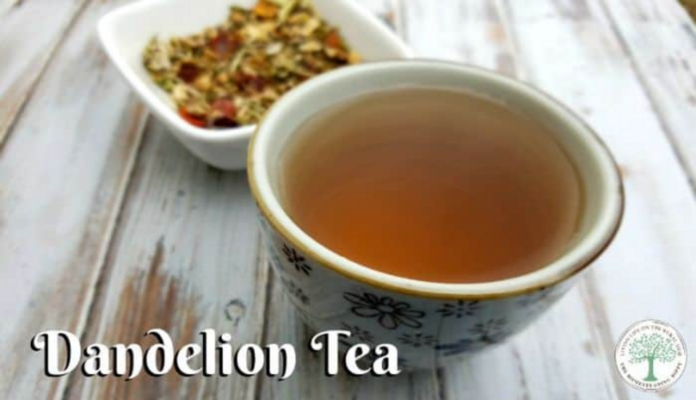How to make dandelion tea from dandelion roots
Dandelions are a first food for tired, winter weary bees. The bright yellow flowers have so much to offer us from blossom to root.
The roots can be carefully harvested, rinsed, dried, and made into a wonderful dandelion tea.
Dandelion is also known by its Latin name, Taraxacum officinale. Dandelions are diuretic, laxative, nutritive, and dandelion tea can act as a digestive stimulant.
To get the roots, you can forage for them. Dandelions are often as close as your back door. You will know one by it’s easily recognized yellow flower. Look for the deep tooth notched, distinctive green leaves surrounding it.
Carefully dig around the plant, down into the dirt about 1 inch. You will want to make a circle about 1/2 inch from the base of the plant. GENTLY pull the plant from it’s roots, and shake the dirt off.
Save the flower heads and make infused oil, and save the greens for a delicious salad.
One noteworthy thing to remember when digging up dandelions: do not take all your dandelions from the yard. Leave some for the bees. You also want to leave some behind to allow the plants to regrow and spread again.
Remember as a kid when you’d make a “wish” from the dried out dandelion head? Those are the seeds. If you take the whole plant, root and all, that doesn’t leave anything to regrow.
You can easily move the dandelions in your yard to a special spot in your garden by using this method. Just be careful with the roots!
Benefits of the Dandelion Plant
Believe it or not, the humble dandelion plant is highly nutritious and has many health benefits.
Packed with vitamins, minerals and antioxidants, they have long been used in traditional medicine practices around the world, and are an easily sourced veggie that can be used in all sorts of ways, from salads to, my favorite, as an herbal tea or coffee substitute.
Here are some of the nutrients and corresponding benefits of dandelion roots and flowers:
Both are a good source of fiber. This helps to keep the digestive system healthy and promotes regularity.
Dandelion roots and flowers are a great source of Vitamin A. Vitamin A is essential for vision, bone growth, and reproduction.
Dandelion roots and flowers both contain abundant Vitamin C. This vitamin is important for immune system function, tissue repair, and iron absorption. It is also hard to come by in quantity out in the wild, so dandelions are a great source anytime they are in season.
The roots are a fine source of calcium. This mineral is always important for bone health, muscle function, and nerve function.
All parts of the plant contain a lot of potassium. This mineral is important for blood pressure regulation, fluid balance, and muscular contraction.
When you need to rehydrate after some serious effort, potassium is even more important; that’s why you usually see it in sports drinks and fluid replacement supplements.
Dandelion roots and flowers are both contain a good shot of magnesium. Magnesium is important in all kinds of subtle ways in the body, from energy production and muscle function to the nervous system .
The whole plant is a great source of iron. Iron is vital for oxygen transport in the bloodstream, DNA synthesis, and enzyme function.
So, as you can see, dandelion roots and flowers are not only pretty to look at, but they are packed with nutrients that can have powerful effects on your health.
So, next time you see a pesky dandelion in your yard, don’t reach for the weed killer; instead, add these little powerhouses to your diet. You’ll see them in a whole new light after you try these teas, at least, I promise!
Preparing Dandelion Root Tea
Now that you have your dandelion roots, lets get to the fun part. There are many ways you can use them.
Drinking the dandelion roots in an infused herbal dandelion tea is a great way to get some of those benefits I described above.
I like to dry mine first, to avoid possibly losing any to mold, which can result from being left to set out too long.
To dry them, carefully wash off the dirt. Then, using a sharp knife, slice into 1/2 inch pieces.
Lay them on a dehydrator sheet (this is what I use) or in a 200 ºF (93 ºC) oven. Leave for 6-8 hours to allow them to fully dry. Store in a covered container in a cool, dry place. Now you are ready to make your tea anytime you want.
To make a delicious dandelion root tea, simply use the following recipe:
Basic Dandelion Root Tea Recipe
Ingredients
- 2 cups water per serving
- 4-5 tsp dried dandelion root per serving
- honey, sugar or cream optional
- cinnamon stick, ginger slice, or unsalted butter for garnish optional
Instructions
-
Place medium pot or saucepan over medium heat.
-
Add 4 to 5 tsp. of dried dandelion root to the pot.
-
Gently roast root until browned and aromatic.
-
Pour over 2 cups of water. Stir.
-
Bring to boil. Reduce heat and simmer for half an hour.
-
Remove from heat, and strain,
-
Pour into mug., garnish and sweeten (if desired).
And that is it! It really is that easy to make a wonderful dandelion root tea, and you might be surprised how good it tastes, especially with a little cream and sugar.
Sure, it is closer to a coffee in taste than a true tea, but if you want something that is lighter and has a more delicate flavor check out the next recipe, one made with dandelion flowers instead of roots.
Bonus Dandelion Tea Recipes
Dandelion Flower Tea Recipe
There is so much more you can do with both dandelion root and dandelion flowers when it comes to making healthy, energizing drinks, both hot and cold.
Below you will find some of my favorite recipes that I have gathered from around the web.
Whether you want an immune system boosting coffee replacement or a supremely refreshing dandelion-raspberry iced tea on a hot day, you’ll find something below, I promise.
Ingredients
- Dandelion flowers, fresh, 4 or 5 per serving
- Water, 2 cups per serving
- Honey or sugar (optional)
- Lemon or lime wedge for garnish (optional)
- Remove stems and leaves from dandelions. Wash flowers in colander or strainer with sprayer
- Pluck petals. Place petals in small pot or large glass jar.
- Heat water to boiling in separate pan. Carefully pour water over petals.
- Remove from heat. Let petals steep for 10 minutes.
- Strain. Sweeten to taste and garnish with lemon or lime wedge.
- For iced dandelion flower tea, allow to cool after straining then pour over ice.
Iced dandelion flower tea is one of my favorite things on a hot summer day, and a great way to pack in some extra nutrition, too.
Immune Boosting Dandelion Chicory Coffee
You already know that dandelion root makes a pretty good coffee substitute all on its own, but what happens when you add some chicory root to the mix also?
The result is a tasty, bold coffee substitute that still goes down smooth and has a wondrous effect on the immune system.
This is a great drink to enjoy in the winter time when people get more prone to sickness and you still need a little help getting out of bed in the morning. Recipe is here.
Iced Raspberry-Dandelion Tea
I mentioned above that a dandelion flower tea goes great with a garnish of lemon or lime, but how can you make it even more refreshing?
Easy enough with some red raspberry leaves and the juice of a handful of limes. Quench your thirst, recharge your vitamins and get plenty of antioxidants at the same time. Find the recipe right here.
Dandelion-Chai Tea
Chai tea is a fixture at breakfast and dinner tables alike all around the world. Hot, iced, latte, there are as many variations of basic chai tea as there are herbs and spices in this famous drink.
You can take your dandelion tea to the next level by adding in some traditional chai tea spices along with your dandelion root. Get the recipe.
Energizing Dandelion Root Herbal Tea
Sometimes you need some extra pep in your step, or something to clear your head.
Dandelion root has excellent health benefits all around as we have learned, but you can warm it up and make it tastier with the addition of cardamom and cloves. This drink is great in winter and summer alike. Get the recipe here.

